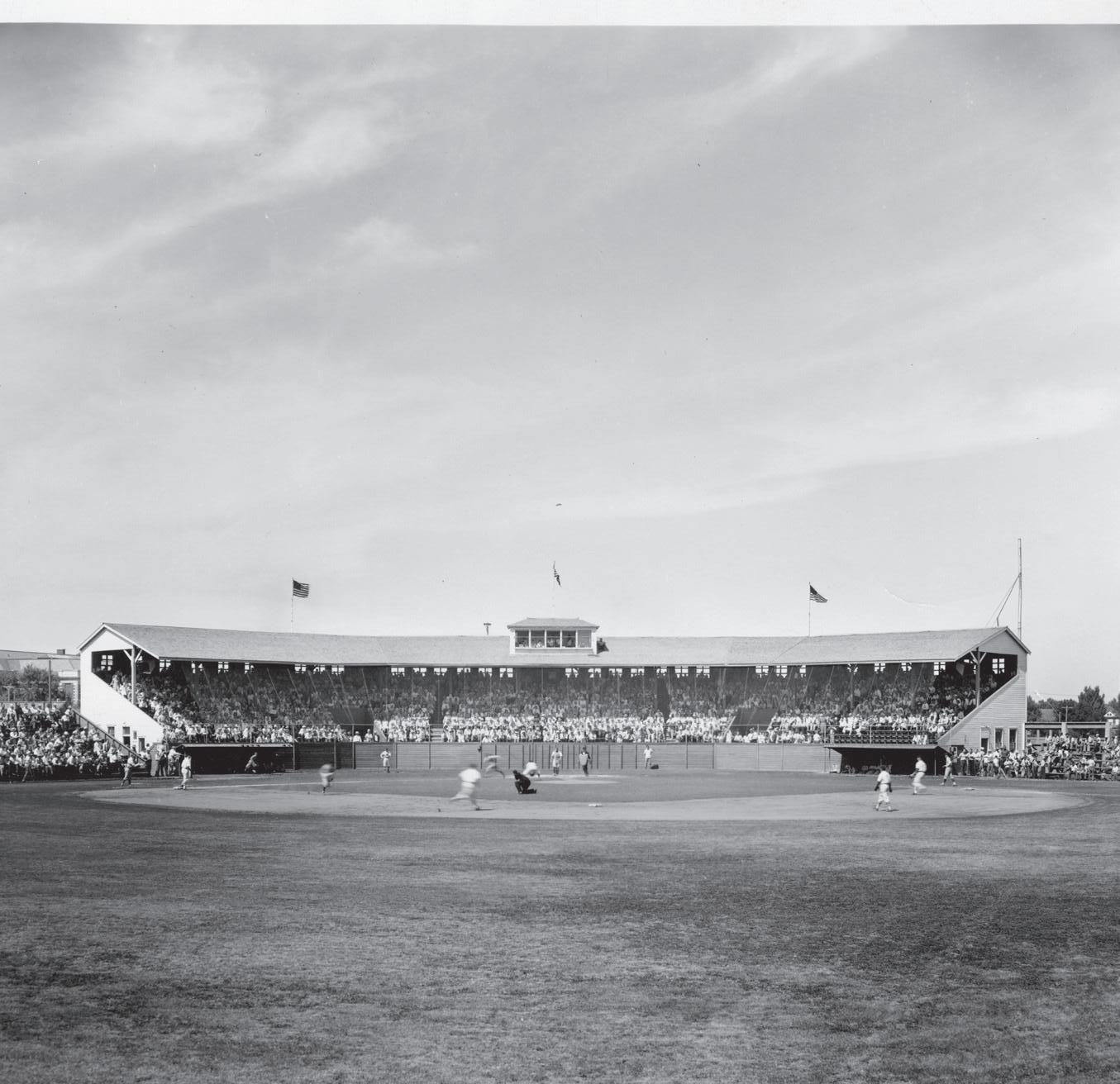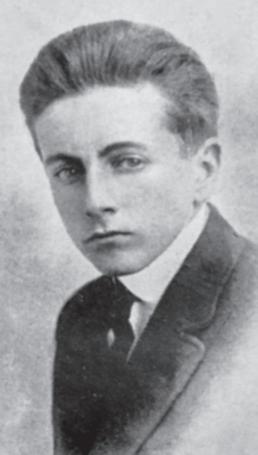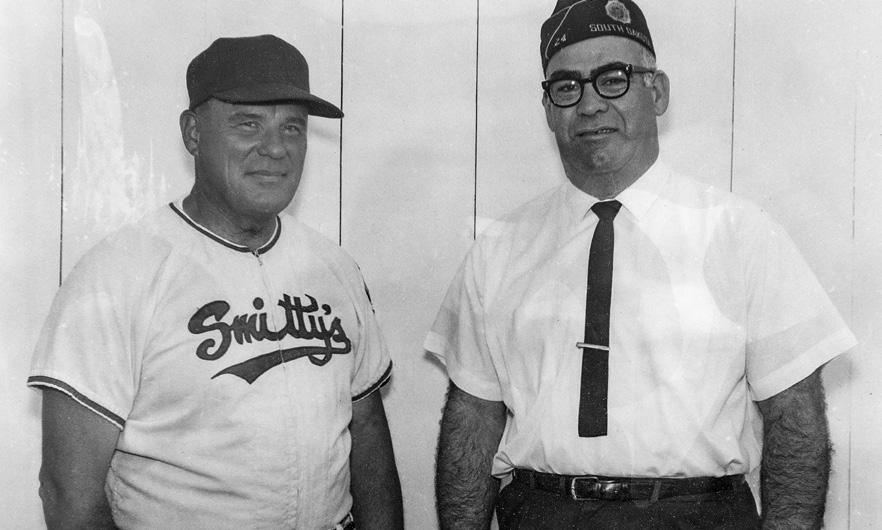
13 minute read
NUFF SAID: REEDY FOSSUM AND THE HEYDAY OF SMITTYS BASEBALL
by PATRICK GALLAGHER
Before the Barnett Center was built on NSU’s Campus, Aberdeen’s baseball stadium stood in its place. It was originally built east of NSU’s campus, but the college acquired land, east of the stadium, land-locking the stadium within state property. The state bought the stadium from Aberdeen for $175,000 in the mid 1960s which was an adequate sum to build a new facility for both baseball and football. The original stadium burned on August 3, 1951 and a $65,000 bond was approved, in its second attempt, by voters to rebuild it.
Advertisement
Seeing what could be a “once in a lifetime opportunity,” a generation of Smittys baseball players will descend on Aberdeen this summer for a reunion and, of course, a Smittys game. Organizer Gene Herold says the idea came when he and some former Smittys were together at a school reunion in Arizona. “Of course, we spent most of the time talking about playing baseball on the Smittys. Great stories, some exaggerations, but enjoyable,” he said. “A lot of our stories centered around Coach Reedy.”
Reedy is Reedy Fossum, who coached the Smittys in 1946-1948 and 1959-1973, the “heyday of Smittys baseball,” said former radio announcer, and Smitty, Gene Reich. Gene Herold noted, “Reedy was an important part of the Smittys program and had an outstanding career coaching,” and, he added, was a “hell of a bus driver.” More on that later.
A 1933 Central graduate, Reedy played football, basketball, tennis and high school baseball, but apparently not Smittys ball. After Naval service in World War II, he came back to Central to teach for many years. Gene Herold remembers, “Reedy provided me with a lot of information (baseball magazines) on how baseball impacted economics. In Reedy’s class, we spent so much time talking about baseball, I don’t remember what he taught.” The class was “Modern Problems.”
Reedy ’s love for baseball translated into love for its history, and in 1976, he produced a summary of the Smittys’ first 50 years as a team, which is available in the Aberdeen library (his history includes player rosters for almost every season, but he is not listed as a player). In 1925, the national American Legion baseball program started at a state Legion convention in Milbank. Reedy’s history credits Aberdeen Legionnaire Frank Sieh with the idea of creating a youth baseball program. The convention adopted it as a resolution and forwarded it to the national convention, which also adopted it. Aberdeen’s team was formed in 1926.

Coach Reedy Fossum with bat boy Gene Reich in the early 1960s. Photo provided by Dan Holdusen, Smittys reunion organizer, team member.
Reedy found that records of the early seasons were sometimes impossible to find. Newspapers didn’t religiously cover games, and coaches didn’t always report information to them. Plus, the team typically played only a handful of games. But by 1930, the Smittys won their first state championship, the first of 15 in those first 50 years. There were more postseason games than in the four-game regular season. After the state tourney, the team played in a national regional tournament against Minnesota, Wisconsin and North Dakota teams. That state title might require an asterisk, however. Reedy reports that in 1930, some players had used their younger brothers’ birth certificates to qualify to play. Since they got away with it, they tried again in 1931, but someone recognized them during the district tournament, and Aberdeen was disqualified from the regional tourney.
The seasons became more organized, and games numbered in double digits, though the Smittys typically played teams within about a 100-mile radius. In 1939, the team won the state tournament again and hosted the four-state regional tourney in which they beat Cheyenne and lost to Omaha. The World War II years were good for the Smittys. They won State again in 1942, losing in the four-state tournament; 1944, when they also won the regional tournament in Miles City, Montana, but lost in the next level in Billings; and 1945, when they lost again in the four-state tilt. This success came despite—or perhaps because of—the Smittys’ participation in the Aberdeen City League, a league of adult amateur teams and stronger competition. It was likely a win-win. As its numbers were down due to men joining the service, the City League needed more teams. Further, playing in the League might have allowed
WHY SMITTYS?

The Aberdeen American Legion Post had named itself after Private First Class Sidney Lawrence Smith (above), who was killed in action in World War I in France in 1918. The post was officially called, “Sidney L. Smith Post No. 24.” Born in Illinois, Smith had moved to Aberdeen in 1915 and joined the South Dakota National Guard. His father was S. Lincoln Smith and was a professor at Northern. They lived in the Dorian Flats apartments on 7th Avenue SE and Lincoln Street. Sidney, or “Larry” as he was called, was the first Aberdeen soldier (U.S.) to die in the war. According to Reedy Fossum’s history, in the mid-1930s, Aberdeen sportswriter, broadcaster, and South Dakota Sports Hall of Fame inductee Larry Desautels nicknamed the baseball team after the Post’s name. As Reedy concluded, “So, thanks Larry [Desautels]. We are proud of that name and hope we can live up to it.”
the Smittys to reduce travel costs during the lean war years.
In 1946, significant changes came. The Smittys stopped playing in the City League. The Aberdeen Pheasants professional minor league team came to town—and everyone had to work around their schedule. And Reedy Fossum returned from the war and coached the Smittys to be state runner up. Changes continued in 1947. The Eastern South Dakota (ESD) baseball conference started with most of the school sports conference teams. The ESD operated for five years, and the Smittys won the conference title each year; then it folded. It started up again in 1960, and Aberdeen won five of the first eight seasons. In addition, in 1947, Reedy led the team to another state championship, although it didn’t get through the four-state tournament.
In addition to the Smittys, Aberdeen’s municipal ballpark was the home of three other champions in 1947: The Pheasants won the Northern League pennant; the Pred’s City League team (on which Reedy played) won the state amateur title; and the Aberdeen Junior-Junior team also won State. That ballpark was where the Barnett Center is now. “It was a beautiful ballpark,” Gene Reich notes. “Teams liked to come and play us in the minor league park.”
It’s not clear from Reedy ’s history why he stopped coaching the Smittys after the 1948 season, but the Smittys continued winning. Between the 1949 and 1960 seasons, the team would win eight more state championships: 1949, 1950, 1952-1956, and 1960. Booge Nicholas started coaching in 1952 and won championships in all five of the seasons he coached.


Coach Reedy Fossum painted by Mary Gorder Groth, provided by Dr. Stanley and Carlie Ryman.
That 1960 title came in Reedy’s second year back with the team—he had taken them to the championship game in 1959. His history begins to show a little more editorial commentary around this time. Writing about the 1960 championship, after which the Smittys lost the playoff game against the Class B champion to qualify for the four-state tournament (a playoff instituted when teams were divided into classes in 1950), he commented,
American Legion Athletic Chairman Al Swanson and Coach Reedy Fossum in 1968. Photo courtesy of Dr. Stanley and Carlie Ryman “the team had a good season; came from behind and won the State A tourney only to lose to Howard in the play-offs—at Howard. Nuff said. [Italics added]”
A lasting change with Reedy’s return to the helm was an expansion of the schedule. In 1958, they played 29 games, and in 1959, they played 40—50 games. More would not be uncommon in ensuing years. Gene Reich was Reedy’s batboy in 1964- 1966 and remembers, “Being batboy for Smittys was a big deal. Reedy called my parents because they travelled so much.” He continued, “Reedy was a hustler so they played all over.”
In 1962 and 1963, the Smittys returned to State, losing both years in one-run games to Rapid City. Perhaps a harbinger, it would not be the last time Rapid City spoiled title dreams. But not in 1964. Summarizing the season, Reedy wrote: “With all due respect to the ’64 team, you could call them the hitless wonders. They had a batting average of .254.” But, “Their ERA was 1.68!!!” At State, the Smittys dispensed with Rapid City early and took the title again, moving on to what was now a seventeam national regional, where, Reedy wrote, “the main thing in my mind was that we wouldn’t look bad getting beat. I couldn’t see how we could score against seven state champions. So what happens?” They went 4-2 in the tourney, winning 3 games by 1-0 scores and losing their last game 1-0 to future major leaguer Rich Folkers. The Smittys pitcher Dave “Tilley” Hottman pitched 27 innings in the seven-game tournament, giving up only the winning run in the last game. This would be the Smittys’ last state championship for more than 40 years. In 1969, after beating Rapid City, they lost to Sioux Falls in the title game, and in 1966, 1973, and 1976, they lost to Rapid City in the championship. As Gene Reich reflected, “Rapid City caught up to us.”
Obviously, the Smittys remained good. The 1967 team finished 45- 8, “One of the best teams I ever coached,” Reedy wrote. “All of this only to lose to Pierre in a heartbreaker 2-1 in the last of the 9th. Leading 1-0 with two out and then to get beat with a fluky hit to left.” Then, regarding the 1972 team’s loss in the state regional tournament, came the comment that might earn a fine today: “One doesn’t like to say that Umpires beat you but in this case both Watertown and Aberdeen got the business. One would have to see it to believe it. Nuff said.” A year later, it was “Nuff said” for Reedy’s coaching career. He retired but continued to schedule for the Smittys and support amateur sports programs.
Several Smittys alumni who plan to attend the upcoming reunion reflected on their playing days under Reedy. South Dakota Sports Hall of Fame inductee and former coach of NSU women’s basketball Curt Fredrickson, who played for Reedy in the 1970s and coached the Smittys twenty years later, credits Reedy as an influence. “He was a very fundamental, old time, old school coach. We all had to learn to bunt to play for Reedy, even the power hitters.” He added, “He did a good job of treating everyone the same.”
Gene Reich was a batboy in 1964- 1966, shortstop in 1968-1969, and assistant coach in 1972-1973 while he was in college, all for Reedy. As
A group of Smittys alumn met up in Phoenix last year for a class reunion. While chatting, they discussed a reunion for Smittys players in Aberdeen. Left to right are Jerry Hauck, Ron Klingman, Gene Herold, and Wally Johnson. They all played together in only one year, 1960. They won the State A tournament and Wally was named Legion Player of the Year. a batboy, he says, “I learned a lot of baseball by sitting on the bench with him.” As the coach, “Reedy kept all the information for the team and scheduled everything. He was a hustler. He raised money like mad because other teams didn’t travel like we did, and Reedy got us the best equipment.” He also acquired several uniform sets so, as Gene said Reedy would say, “At least you can look like a ballplayer.”
While preparing to attend his five-year-old grandson’s batting practice, George Amundson, another South Dakota Sports Hall of Fame athlete who played for Reedy, said, “Reedy was the man!” He occasionally had an assistant coach, but “He pretty much did everything, all the planning, including driving the bus. He was the third base coach and a player coached first base.” From third, Reedy gave his signs telling the batter what to do, and if you missed the sign, George said, Reedy would yell, “Good God!” In that vein, Jerry Hauck mentioned, “Actually my most vivid memory of Reedy was how red his face and bald head got when he was excited/angry.”
Wally Johnson, who was named Legion State Player of the Year in 1960, remembers a similar reaction, “I was attempting to steal second. Noticing that nobody was covering the base I did not slide. The catcher threw the ball to the base which struck me on the head (no helmets at that time). I went

down to the ground somewhat dazed, looked toward third, and saw Reedy coming towards me on a trot, feeling good that my coach was concerned, I rubbed my head and stayed down waiting for Reedy. Upon his arrival I heard, ‘What are you doing on the ground? The ball is in left field and you should be on third.’ After that I never looked for any sympathy from Reedy.”
In a seemingly questionable innovation, Reedy tried to extend the life of their wooden bats. Curt said, “He put fiberglass from the handle up to the trademark then adhesive tape over that. He thought it kept the bats from breaking.” Gene Herold added, “The first bats were a little rough on the edges. In fact, the fiberglass and webbing drew blood when gripping the bat. I don’t know how Reedy convinced the umpires that these bats were legal.”
Another common memory of Reedy concerns transportation. The Smittys had their own bus, because they sometimes had long, seven-day, multi-state road trips, and Reedy was the driver. George remembers, “He’d buy a bottle of No Doz and eat it like candy, and he’d drive with his elbows on the steering wheel and his hands on his cheeks.” Curt added, “We had to ask him if he’d taken his No Doz. He’d nod off and that kept you on your toes.”
R e e d y ’s 3 0 - p l u s y e a r commitment to the Smittys earned him the honor of having the new
SMITTYS STATE CHAMPIONSHIPS
Single Class Champions
1930 1939 1942 1944 1945 1947 1949
Class A Champions
1950 1952 1953 1954 1955 1956 1960 1964 2008
Provided by Tom Hurlbert
baseball field on the northeast side of town named after him, and the Smittys still play at Fossum Field, where they won the 2008 state championship. Gene Reich got to call that game on the radio. After being batboy for the Smittys last championship in 1964, he said, “That was a big deal for me.”
Reedy died in 1989, and Gene Reich delivered a eulogy for him. A longtime educator, athlete, coach, and administrator at the high school and amateur levels, his obituary lists numerous accolades, including induction in the South Dakota Baseball Hall of Fame. Another honor will come this summer, when some of his biggest fans return to the ballpark named after him to celebrate him and what he brought to their lives. //
SMITTYS BASEBALL REUNION
WHEN: July 10-11, 2020, Including recognition at the July 11 Smittys game.
Reunion plans are current as of early summer, pending pandemic conditions. As organizer Gene Herold reports, “We are in the “bus” going down the road and hoping the reunion will be played on time, but we just don’t know what the “COVID 19” will be like when we get there. We may have to stop at a roadside cafe to have “hot beefers” before we continue on to the reunion.”
Former Smitty Craig Hayes, observed, “These are truly unprecedented times. As Reedy would say, don't get your dauber down.”










